Shooting Gear
I've decided that I should review some of the various pieces of kit that I've come across (that are neither optics nor firearms), for the benefit of others. I have no relationship with any of the vendors or suppliers, and all of the items were obtained through normal retail channels.
Safety
UVEX Magic Goggles F1

Review Date: 02.05.2011
Vendor: Ski Universe
Price: $129.00
Pros: These goggles are lightweight, ventilated and well padded, and feature the unique ability to convert from clear lenses to sunglass lenses in a fraction of a second at the push of a button. The technology enabling this feature is an LCD insert sandwiched between two plastic lenses, originally developed for the US Air Force.
Cons: Peripheral vision is more limited than in other goggles. Not sure about ballistic/shatter or UV protection.
ESS Profile NVG Goggles

Review Date: 06.06.2008
Vendor: Optics Planet
Price: $85.50
Pros: These goggles are lightweight, low-profile, and protect your eyes from both dust and shrapnel with distortion-free high-impact lenses. I got them for shooting with suppressors, which can be a gassy and dirty business. What's especially nice is that you get two sets of lenses, one clear and the other gray -- both providing 100% UVA/UVB protection. Eyeglass-wearers will be interested in knowing that they are compatible with ESS RX lens inserts.
Cons: The speed-sleeve carrying pouch that came with the goggles is not very durable; I keep them in a Tactical Tailor Accessory Pouch 1H.
MSA-Sordin Supreme Pro-X Headset (OD)
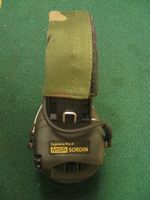
Review Date: 06.05.2008
Vendor: Botach Tactical
Price: $199.95; add $39.00 for the gel inserts available from CSUK
Pros: These earmuffs amplify ambient sounds using dual waterproof microphones, letting you hear everything going on around you in stereo (you can therefore sense what direction sounds are coming from), while at the same time remaining protected from harmful sounds like your firearm's report! The amplifier is powered by two AA batteries (included!), and features a four-hour auto shut-off. In spite of their extremely slim profile -- they are among the slimmest earmuffs I have seen -- the level of sound-dampening rivals that of much bulkier models. The gel-filled inserts are comfortable, and easily accommodate eyeglasses without compromising performance. A must-have item!
Cons: Doesn't come standard with the gel-filled seals or a carrying case.
Range Gear
TAB Shooting Mat
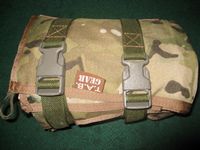
Review Date: 05.27.2008
Vendor: RiflesOnly
Price: Starting at $64.00, $97.50 as configured.
Pros: Well-constructed and easily portable, the TAB shooting mat features a number of well-thought-out features. It is designed to fold in such a way as to sandwich any dirt and mud away from the surface of the mat, and it features an integral padding strip that is well-positioned for the elbows. The model reviewed featured gromets, tent stakes and a small pocket to hold the stakes, to keep the mat secure in windy conditions.
Cons: The included aluminum tent stakes are rather fragile and prone to bending; so I'll be looking for a plastic substitute that will fit in the pouch.
Anti-Cant Devices
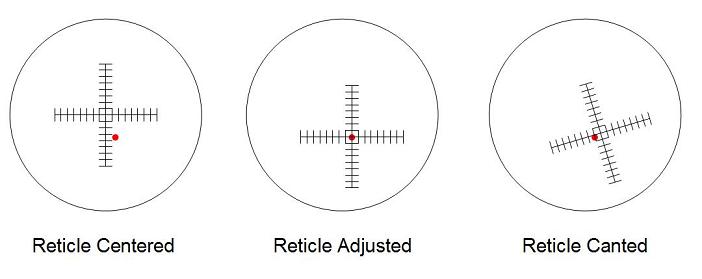 Accuracy is really all about consistency, and consistency requires repeatability. The graphic on the right shows a series of illustrations of a target as viewed through a scope that demonstrate the effect of rifle cant on accuracy.
Accuracy is really all about consistency, and consistency requires repeatability. The graphic on the right shows a series of illustrations of a target as viewed through a scope that demonstrate the effect of rifle cant on accuracy.
In the image on the left, the reticle is centered in the scope and the point of impact (POI) is represented by the red dot that is off-center. The center image shows the reticle corrected to align with the POI -- this is what actually happens when you adjust your scope for windage and elevation: the reticle is displaced within the scope tube. The image on the right is an exaggerated rotation of the adjusted reticle, but the position of the POI relative to the true center of the field of view (FOV) has not been changed.
Notice that with the scope canted, the cross-hairs no longer line up with the POI. If you were to center the cross-hairs over the target in this scenario, the actual POI would shift by a corresponding amount. The amount of shift becomes more noticable at longer ranges because your reticle will be adjusted far down in the FOV, towards the bottom end of its ability to travel. The resulting lengthened arc from the true center of the FOV translates into a greater relative deviation for a given amount of cant, and an even greater absolute distance from your intended target at long ranges.
A number of devices are marketed to help shooters avoid this phenomenon. I have both fixed and swivel rail-mounted levels, a swivel scope-mounted level, and an electronic level device.
Rail Mounted Swivel Bubble Level

Review Date: 04.03.2009
Vendor: US Optics
Price: $88.00 ($68 for the fixed version, $73 and $83 for the scope-mounted type for fixed and folding versions, respectively)
Pros: Easy to use, protective cover can be securely stowed when the level is in use.
Cons: The bubble is not very sensitive -- it's really not much better at consistently determining level than your own kinesthetic sense should normally be. Mounting positions are limited with the folding version if you have any dials on the left-hand side of your scope (like an illumination dial). Also, the hinges can cause the level to tilt down, so they're not necessarily perfectly level with your mount. The finish is easily scratched on the corner edges, which themselves can easily scratch your scope when mounting. Beveled edges would be nicer.
Deros Level Grouse

Review Date: 04.03.2009
Vendor: Alamo Four Star (buy from Phoenix Tactical)
Price: $129.00 (add a Picatinny rail mount for an additional $69 -- but I prefer mounting these directly to the scope using a ring)
Pros: Extremely sensitive, simple and intuitive to use. Far superior to a bubble level. With both eyes open the lights appear to "float" inside the scope.
Cons: The unit can take several seconds to "settle down" when knocked (both lights flash). It can be difficult to get the batteries out of the sleeve (or the sleeve out of the tube) to change them. Alamo Four Star's customer service is beyond abyssmal; order these through Scott at Phoenix Tactical.
Other Shotting Aids
Swarovski 8x30 Laser Range Finder
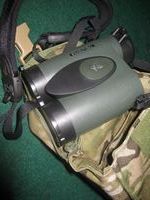
Review Date: 10.06.2008
Vendor: Optics Planet
Price: $939.00
Pros: Exceptionally clear glass, and accurate ranging out to over 1000 yards. What more could anyone want?
Cons: Doesn't come with separate lens covers for the objective and laser receiver lenses (the included carrying case serves this function), but you can follow these instructions for customizing flip-up lens covers to remedy that.
Kestrel 2500NV Weather Station

Review Date: 10.06.2008
Vendor: Circuit City
Price: $139.99
Pros: The only way to make sense of windage is to construct tables reflecting the deflection of your load at known distances because of the wind speed orthagonal to your shot. A Kestrel is therefore a necessary complement to your LRF, for accurate long-range shooting.
Cons: Construction does not seem exceptionally rugged, and there is no separate carrying case. Red-Tac Gear makes a nice one, however.
Mildot Master
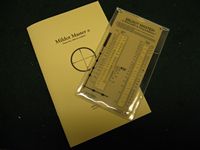
Review Date: 05.27.2008
Vendor: U.S. Tactical Supply
Price: $29.95
Pros: The Mildot Master is reminiscent of the PADI wheel, or my old Jeppesen E6-B flight computer. Simple, reliable, impervious to EM pulse, it makes ranging and hold-over determinations with a mildot reticle very easy. Consider it a back-up for your pricey LRF. Made from heavy vinyl stock for water and dirt resistance.
Cons: Too bad there isn't a model made of hard-annodized aluminum.